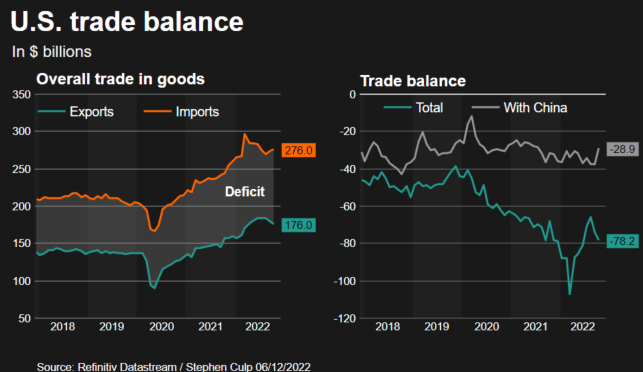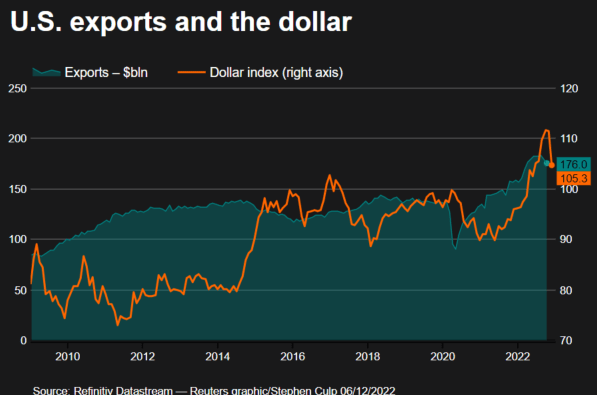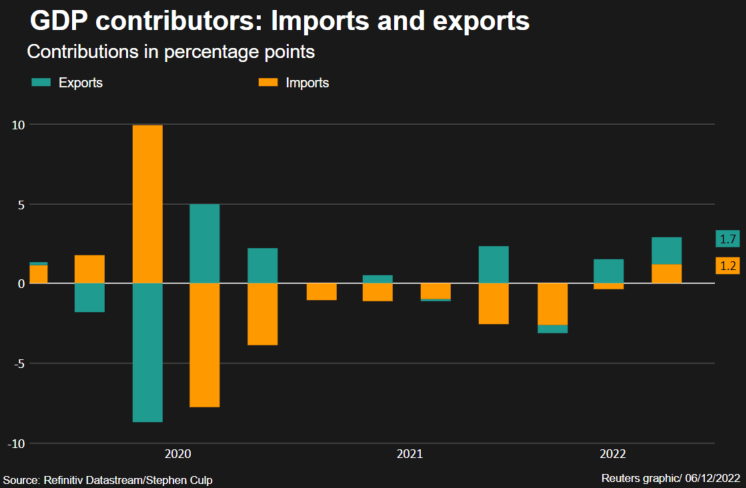U.S. trade deficit widens as goods exports hit seven-month low

The U.S. trade deficit widened sharply in October as slowing global demand and a strong dollar pushed goods exports to a seven-month low, suggesting that trade could be a drag on economic growth this quarter if the trend persists.
The report from the Commerce Department on Tuesday, which followed on the heels of recent upbeat news on the economy ranging from consumer spending, the labor market to the services industry, did not change perceptions that the economy had got off to a solid start in the fourth quarter.
“A rewidening in the trade balance will mechanically weigh on GDP growth fourth quarter,” said Veronica Clark, an economist at Citigroup in New York. “However, this should be partly offset through strength in domestic demand, particularly in business investment as real capital goods imports have jumped in the last few months.”
The trade deficit increased 5.4% to $78.2 billion. The second straight monthly widening in the trade gap was partly driven by a shift in pharmaceutical products trade, with exports of these goods falling sharply and imports surging.

US Trade Balance
“Trade in pharmaceuticals was always notoriously volatile, and it’s only gotten worse with the big international shipments in both directions of COVID vaccines,” said Paul Ashworth, chief North America economist at Capital Economics in Toronto.
Exports fell 0.7% to $256.6 billion, with goods shipments dropping 2.1% to $176.0 billion, the lowest level since March. There were decreases in exports of industrial supplies, which largely reflected natural gas and other petroleum products. Crude oil exports, however, increased $1.6 billion.
Exports of consumer goods fell, pulled down by a $2.2 billion drop in pharmaceutical products. Food exports rose, lifted by soybeans. Capital goods exports were the highest on record. Exports of services raced $1.8 billion to an all-time high of $80.6 billion, boosted by travel, transportation and other business services.
The dollar at one point this year had appreciated more than 11% against the currencies of the United States’ main trade partners from the end of December 2021, the result of the Federal Reserve’s fastest rate-increasing cycle since the 1980s as it fights inflation. As of this month, the dollar was up 5.9% on a trade-weighted basis from the end of 2021.
Dollar strength is making U.S. manufactured goods less competitive on global markets. Monetary policy tightening by global central banks is also eroding demand.
Surveys from the Institute for Supply Management this month showed measures of manufacturing and services exports stuck in contraction territory in November.
Stocks on Wall Street were trading lower. The dollar eased versus a basket of currencies. U.S. Treasury prices rose.

US Exports dollar
Imports increased 0.6% to $334.8 billion, with goods climbing 0.9% to $275.6 billion. They were driven by industrial supplies and materials as well as other goods.
Imports of automotive vehicles, parts and engines were the highest on record.
But consumer goods imports dropped, pulled down by cell phones and other household goods as well as toys, games and sporting goods. Imports of pharmaceutical preparations increased $2.7 billion.
The overall decline in consumer goods imports is in line with slowing demand for goods because of higher borrowing costs. Spending is also rotating back to services. Tough COVID-19 lockdowns in China have disrupted production at factories, resulting in shortages of Apple’s (AAPL.O) new iPhone.
Imports of services fell $0.2 billion to $59.2 billion, reflecting declines in transport. But travel services increased as did telecommunications, computer and information services.

US Trade GDP
Adjusted for inflation, the goods deficit increased $8.3 billion to $112.6 billion in October. So-called real goods exports decreased $4.0 billion to $158.4 billion. Real goods imports increased $4.3 billion to $271.0 billion.
Economists said even stripping out the distortions from pharmaceuticals and new iPhone shortages, trade was on track to subtract from gross domestic product this quarter.
A smaller trade deficit contributed 2.93 percentage points to the economy’s 2.9% annualized growth pace in the third quarter. Growth estimates for the fourth quarter are as high as a 3.4% rate.










